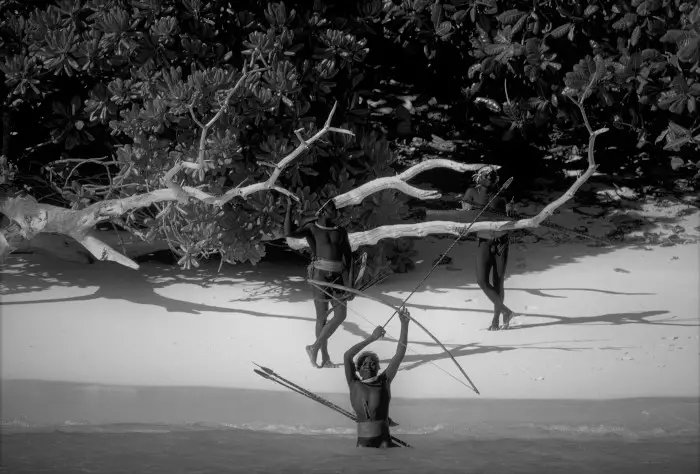 he Andaman Islands are located in the northern part of the Indian Ocean in the Bay of Bengal. The North Sentinel island, part of this archipelago, is noted for the fact that there live hundreds of people who form the last pre-neolithic tribe in the world. The Sentinels, as they are called the members of this civilization, represent the most isolated tribe in the world.
he Andaman Islands are located in the northern part of the Indian Ocean in the Bay of Bengal. The North Sentinel island, part of this archipelago, is noted for the fact that there live hundreds of people who form the last pre-neolithic tribe in the world. The Sentinels, as they are called the members of this civilization, represent the most isolated tribe in the world.
The Andamanese tribes
The Andaman Islands have been inhabited for at least 60,000–70,000 years, the first people to arrive here from India or Burma following the Great Migration from Africa to the East, which took place about 20,000 years before Europe was inhabited. For thousands of years, the societies that populated this archipelago were not disturbed by any external influence, which led to the development of several indigenous groups, including the Great Andamanese, Jarawa, Onge, Shompen, Jangil, and the Sentinels.

It is estimated that in 1789 there were 10,000 members of the Great Andamanese group. In the middle of the 19th century, the British transformed the Andaman Islands into a penitentiary colony, eliminating the locals who opposed the arrival of the intruders. Andamanese who was not attacked by the British died as a result of contracting modern diseases. In 1901, the number of Andamanese had been reduced to 600, and in 1927 to 100. Today, only 52 Andamanese live.
Many of the detainees remained here and after the punishment, the islands with a tropical climate and white sandy beaches are attractive to many deported Indians. Over time, many settlers from India and Burma also settled here, which also contributed to the decimation of the archipelago tribes.
The Jangil tribe disappeared in the early 20th century, followed by Oko-Juwoi and then most of the other peoples of the archipelago. However, their fate was not shared by the Jarawa and Sentinel tribes, who violently rejected any connection with the outside world. Eventually, however, the Jarawa tribe accepted the contact in 1998, and now its existence is threatened by measles and tourism, poachers hunting for food, and by expanding settlements and roads built by settlers living in the archipelago.
Sentinels Tribe
The Sentinels did not let their guard down, continuing to deny any contact with foreigners. For this reason, they represent one of the last populations on the planet untouched by modern civilization.

The sentinel civilization is technologically within the category of the stone age. Sentinels are the only population on Earth to maintain a paleolithic lifestyle, their livelihood depending on harvesting, hunting, and fishing. According to some reports, they can clean coconuts with their teeth and fish with spears and bows with arrows. These tools are also used to hunt wild boars, turtles, and snails living on the island. Agriculture, on the other hand, is foreign to them.
Also, the Sentinels have built canoes that they use to move in shallow waters near the shore, but they are not equipped with rows. The propulsion is realized by pushing with poles. The sentinels use the fire, which they hide and guard with great strain because they do not know how to obtain it. Their language is unique in the world and does not even resemble those spoken in the rest of the Andaman archipelago. Beyond this, nothing is known about sentinel.
North Sentinel’s population is estimated to be somewhere between 50 and 400 people. An exact number cannot be obtained because the sentinels are not friendly to visitors. Moreover, the 2001 census was carried out from a distance by the representatives of the Indian government, of which the island belongs. The official results counted 39 people (21 men and 18 women), but the authorities acknowledge that they do not represent an exact measurement of the population of the island which covers 72 square kilometers.
Trying to make contact
Sentinels were discovered in 1771, when a navigator on a British research vessel reported that night was visible on the island, suggesting that it was inhabited. The British ship did not stop to study the island in detail, but the logbook contains the first written mention of the North Sentinel’s population.
After almost a century, in 1867, the Niniveh Indian merchant ship crashed on the reef near the island. The 86 passengers and 20 crew members managed to survive, using a lifeboat to reach the island. On the morning of the third day, the survivors of the shipwreck were suddenly attacked.
The captain of the ship Niniveh managed to escape in the rescue boat and survived, being rescued a few days later by a ship passing through the area. He later reported that “the wild were completely undressed, with short hair and nose painted in red, and their arrows had a metal tip.” Most likely, the sentinels recovered the metal remains of the nearby failed vessels, a behavior observed even today. After a few days, a British Royal Navy vessel recovered the island’s survivors, who had managed to keep the locals away.
In 1896, an Indian who served his sentence in the penitentiary colony of Great Andaman Island managed to escape with the help of an improvised raft. Its boat floated drifting, crossing the approximately 50 miles to North Sentinel Island and crashing along its shoreline. The team detached by the officials of the penal colony to look for the escaped one discovered after three days his corpse on the shore of the island. His neck was severed and his body pierced by arrows in many places.
As a result of this incident, the Sentinels were not disturbed by the intruders for more than half a century.

In 1967, 20 years after taking over control of the Andaman archipelago following independence, the Indian authorities made the first attempts to contact the sentinels. An expedition led by anthropologist Triloki Nath Pandit arrived on the island, leaving a few coconuts on shore, but to no avail — the sentinels hid in the jungle. The researchers tried again to contact the sentinels in 1970 and 1973, but in both cases, they were met with arrows.
In 1974, Pandit embarked on the expedition again, this time with a film crew, trying to establish a connection with the sentinels. He brought them some presents, some fruit, toys, and even a pig. His attempt was rejected, one of the film crew members choosing with a thigh arrow.
The anthropologist did not give up and continued to bring them coconuts, which are not found on the island, and over time he gained their trust. Finally, after 24 years of effort, Pandit managed to reach the island. On January 4, 1991, the expedition led by Pandit was met by 28 unarmed tribe members. Pandit is the only anthropologist who managed to enter the sentinel culture, shattering many myths conceived by the British and the Indians who colonized the Andaman archipelago.
Avid Writer with invaluable knowledge of Humanity!
Upcoming historian with over 30 million views online.
“You make your own life.”





